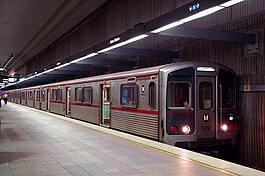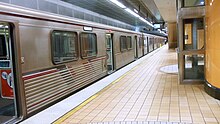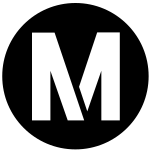B Line (Los Angeles Metro)
| B Line | |||||||||||||||||||||||||
|---|---|---|---|---|---|---|---|---|---|---|---|---|---|---|---|---|---|---|---|---|---|---|---|---|---|
 | |||||||||||||||||||||||||
 B Line train at Union Station | |||||||||||||||||||||||||
| Overview | |||||||||||||||||||||||||
| Other name(s) | Red Line (1993–2020) | ||||||||||||||||||||||||
| Owner | Los Angeles County Metropolitan Transportation Authority | ||||||||||||||||||||||||
| Line number | 802 | ||||||||||||||||||||||||
| Termini | |||||||||||||||||||||||||
| Stations | 14 | ||||||||||||||||||||||||
| Website | metro | ||||||||||||||||||||||||
| Service | |||||||||||||||||||||||||
| Type | Rapid transit | ||||||||||||||||||||||||
| System | Los Angeles Metro Rail | ||||||||||||||||||||||||
| Depot(s) | Division 20 (Los Angeles) | ||||||||||||||||||||||||
| Rolling stock | Breda A650 or CRRC HR4000 running in 4 or 6 car consists | ||||||||||||||||||||||||
| Daily ridership | 64,729 (Weekday, May 2024) | ||||||||||||||||||||||||
| Ridership | 25,899,711[a] (2023) | ||||||||||||||||||||||||
| History | |||||||||||||||||||||||||
| Opened | January 30, 1993 | ||||||||||||||||||||||||
| Completed | June 24, 2000 | ||||||||||||||||||||||||
| Technical | |||||||||||||||||||||||||
| Line length | 14.7 miles (23.7 km)[1] | ||||||||||||||||||||||||
| Number of tracks | 2 | ||||||||||||||||||||||||
| Character | Fully underground (except yard) | ||||||||||||||||||||||||
| Track gauge | 4 ft 8+1⁄2 in (1,435 mm) standard gauge | ||||||||||||||||||||||||
| Electrification | Third rail, 750 V DC | ||||||||||||||||||||||||
| Operating speed | 70 mph (110 km/h) (max.) 33.9 mph (54.6 km/h) (avg.) | ||||||||||||||||||||||||
| |||||||||||||||||||||||||
The B Line (formerly the Red Line from 1993–2020) is a fully underground 14.7 mi (23.7 km)[1] rapid transit line operating in Los Angeles, running between North Hollywood and Downtown Los Angeles. It is one of six lines in the Los Angeles Metro Rail system, operated by the Los Angeles County Metropolitan Transportation Authority. Built in four stages between 1986 and 2000, the line cost $4.5 billion.
The B Line is one of the city's two fully-underground subway lines (along with the D Line). The two lines share tracks through Koreatown and Downtown Los Angeles. As of 2019[update], the combined B and D lines averaged 133,413 boardings per weekday.[2]
In 2020, Metro renamed all of its lines using letters and colors, with the Red Line becoming the B Line (retaining the red color in its service bullet) and the Purple Line becoming the D Line.
Service description
[edit]Route
[edit]The B Line is a subway that begins at North Hollywood station in North Hollywood, in the San Fernando Valley. The line turns southeast underneath Cahuenga Pass and passes through Hollywood and Koreatown, traveling east along Hollywood Boulevard and then south along Vermont Avenue. Arriving at Wilshire/Vermont station, the line merges with the D Line, and the lines continue between Wilshire Boulevard and 7th Street (and briefly Ingraham Street), where the lines interchange with the A and E light rail lines at 7th Street/Metro Center station. The lines then pass northeast through Downtown Los Angeles, passing through the Financial District, Pershing Square (near the Historic Core), and the Civic Center, before terminating at Union Station.
The B Line through Cahuenga Pass roughly follows a branch of the old Pacific Electric system.
Hours and frequency
[edit]B Line trains run every day between approximately 4:30 a.m. and midnight. Trains operate every 12 minutes during peak hours. Early morning and night service is approximately every 20 minutes.[3]
| Time | 5A | 6A | 7A | 8A-6P | 7P | 8P | 9P-12A |
|---|---|---|---|---|---|---|---|
| Weekdays | 14-18 | 12 | 20 | ||||
| Weekends/Holidays | 20 | 16-20 | 12 | 20 | |||
Station listing
[edit]The following table lists the stations of the B Line, from north to south. All stations are located in the city of Los Angeles, California.
| Station | Date opened | Neighborhood | Major connections and notes[4][5] |
|---|---|---|---|
| North Hollywood | June 24, 2000 | North Hollywood | Park and ride: 1,085 paid spaces |
| Universal City/Studio City | Studio City | Universal Studios Hollywood shuttle Park and ride: 782 paid spaces | |
| Hollywood/Highland | Hollywood | ||
| Hollywood/Vine | June 12, 1999 | ||
| Hollywood/Western | East Hollywood | ||
| Vermont/Sunset | |||
| Vermont/Santa Monica | |||
| Vermont/Beverly | |||
| Wilshire/Vermont | July 13, 1996 | Mid-Wilshire/Koreatown | |
| Westlake/MacArthur Park | January 30, 1993 | Westlake | Park and ride: 6 spaces |
| 7th Street/Metro Center | Downtown Los Angeles | ||
| Pershing Square | |||
| Civic Center/Grand Park | |||
| Union Station | Paid parking: 3,000 spaces |
Ridership
[edit]Note: Ridership figures are for B and D Line combined.
| Year | Ridership | %± |
|---|---|---|
| 2009 | 47,453,332 | — |
| 2010 | 47,434,969 | 0.0% |
| 2011 | 46,964,495 | −1.0% |
| 2012 | 48,703,612 | +3.7% |
| 2013 | 51,030,536 | +4.8% |
| 2014 | 48,645,206 | −4.7% |
| 2015 | 46,356,726 | −4.7% |
| 2016 | 45,629,352 | −1.6% |
| 2017 | 44,861,106 | −1.7% |
| 2018 | 43,301,200 | −3.5% |
| 2019 | 41,775,490 | −3.5% |
| 2020 | 22,776,524 | −45.5% |
| 2021 | 21,398,104 | −6.1% |
| 2022 | 25,767,716 | +20.4% |
| 2023 | 25,899,711 | +0.5% |
| Source: Metro[6] | ||
Graphs are unavailable due to technical issues. Updates on reimplementing the Graph extension, which will be known as the Chart extension, can be found on Phabricator and on MediaWiki.org. |
History
[edit]The current B Line is the product of a long-term plan to connect Downtown Los Angeles to central and western portions of the city with a subway system. Original proposals in the 1980s had it running down Wilshire Boulevard to Fairfax Avenue and then north to the San Fernando Valley. Residents in some parts of the city bitterly opposed the subway. A 1985 methane explosion at a Ross Dress for Less clothing store near Fairfax gave Rep. Henry Waxman, who represented the Fairfax District, a reason to derail the project that was opposed by his constituents by prohibiting tunnelling in an alleged "methane zone" west of Western on Wilshire.[7] After some political wrangling, a new route was chosen up Vermont Avenue to Hollywood Boulevard.

The groundbreaking for the first segment of the subway was held on September 29, 1986, on the site of the future Civic Center/Grand Park station.[8][9] Today's B Line was built in four minimum operating segments:
- MOS-1, consisting of five stations from Union Station to Westlake/MacArthur Park, opened on January 30, 1993, as the Red Line. (At this point, the line's operator was still the Southern California Rapid Transit District).[10]
- MOS-2A, consisting of three stations from Westlake/MacArthur Park to Wilshire/Western, opened on July 13, 1996, although only one station on this section (Wilshire/Vermont) is on today's B Line.
- MOS-2B, consisting of five stations from Wilshire/Vermont to Hollywood/Vine, opened on June 12, 1999.[11]
- MOS-3, extending the Red Line from Hollywood/Vine to North Hollywood, opened on June 24, 2000.[12][13]
Overall, the construction of the subway over the four phases cost $4.5 billion.[13]
On June 22, 1995, during the construction of MOS-2B, a sinkhole appeared on Hollywood Boulevard, barely missing several workers and causing damage to buildings on the street.[14] Subway construction was delayed during the investigation and repairs of the sinkhole. The contractor on that segment project was replaced, and because of the perceived mismanagement of Red Line construction, in 1998 voters banned the use of existing sales taxes for subway tunnelling.[15]

Construction of MOS-3, by comparison, proceeded with relatively few issues. Tunnelling from North Hollywood for the subway started in 1995. Workers dug under the Santa Monica Mountains using tunnelling machines. Work progressed an average of 50 to 200 ft (15 to 61 m) daily, performed by work crews round-the-clock six days a week.
Original proposals for the subway system included expansions east from Union Station to East Los Angeles and west from North Hollywood towards the Warner Center transit hub in the San Fernando Valley. Barred from subway tunnelling, Metro turned to other types of mass transit. In the San Fernando Valley, residents passed a law in 1991 mandating that any rail line in the area be built underground,[16][17] so Metro built a busway (now the G Line) from North Hollywood to Warner Center, which opened on October 29, 2005. East of Union Station, Metro built a light rail line with at-grade and underground segments to East Los Angeles, now part of the E Line, which opened on November 15, 2009.
Operations
[edit]On Metro Rail's internal timetables, the B Line is called line 802.
Maintenance
[edit]
The B Line operates out of the Division 20 Yard (Santa Fe Yard), located at 320 South Santa Fe Avenue in Downtown Los Angeles. This yard stores the fleet used on the B and D Lines, and where heavy maintenance is performed. Cars reach this yard by continuing past Union Station, making a right turn and surfacing at the Eastern terminus of Ducommun Street. They then travel south to 1st Street, through a washing station, and enter the yard.
Rolling stock
[edit]The B Line uses A650 75 ft (22.86 m) electric multiple unit cars built by Breda in Italy. Trains usually run in six-car configurations during peak hours and four-car configurations otherwise. The cars are maintained in a Metro yard on Santa Fe Avenue near 4th Street alongside the Los Angeles River in downtown Los Angeles.
In March 2017, Metro ordered new CRRC HR4000 railcars, which will operate on the B Line when they are delivered.[18] In January 2024, Metro ordered 182 Hyundai Rotem HR5000 trains, allowing for future replacement of all Breda A650 trains as well as expanded train service including a four minute train frequency.[19]
Potential future extensions
[edit]
Extension to Arts District
[edit]In 2010, at the request of L.A. City Councilman Tom LaBonge, Metro staff studied the possibility of adding a station along the west bank of the Los Angeles River to 6th Street and Santa Fe Avenue. The study concluded that such an extension, completed at-grade along Metro-owned right-of-way, could be completed for as little as $90 million.
The study suggested an alternative station at the Division 20 Yard north of 4th Street and Santa Fe Avenue. This station would be closer to the residential population of the Arts District. As new turnback tracks will need to be built as part of the D Line Extension (to allow shorter headways), this Arts District extension could possibly be partially completed as part of the Purple Line Extension project, lowering the incremental cost of the station while increasing its usability.[20][21]
Extensions to the South
[edit]One of the proposals for the Vermont Transit Corridor being considered by Metro would extend a subway line from Wilshire/Vermont station down Vermont Avenue to 120th Street. Metro is also considering other types of mass transit for the line, including light rail and busway options.
Incidents
[edit]- On December 22, 2006, a rider accidentally spilled a vial of mercury on the platform at Pershing Square station. He notified the operator on a passenger intercom before boarding a train, but Los Angeles County Sheriff's Department did not know of the spillage until eight hours later.[22] In response, Metro implemented new hazardous materials (Hazmat) training to its field employees and operators.[23]
- On August 19, 2011, near the Hollywood/Vine station, an altercation between two passengers resulted in one being fatally stabbed.[24] The suspect was arrested on August 24.[25]
- On September 4, 2012, a 54-year-old man fell onto the tracks at the North Hollywood station and was hit by an oncoming train.[26] He was rushed to hospital, where he later died.[27]
- On May 22, 2018, an unidentified man "probably jumped" onto the tracks at the 7th St/Metro Center station and was hit by an oncoming train. He was rushed to a hospital, where he later died. It is unknown if it was suicide or not.[28]
- On April 20, 2024, a woman in her 50s was stabbed in the throat at the Universal City station shortly after 5am. She was taken to a hospital where she died from her injuries.[29]
Notes
[edit]- ^ Ridership data is combined for the B and D lines.
References
[edit]- ^ a b "Facts At A Glance". Los Angeles County Metropolitan Transportation Authority. June 2023. Archived from the original on March 19, 2023. Retrieved June 22, 2023.
- ^ "Interactive Estimated Ridership Stats". Los Angeles County Metropolitan Transit Authority. January 1, 2020. Archived from the original on June 24, 2021. Retrieved February 10, 2020.
- ^ "B & D Line Timetable" (PDF). Los Angeles County Metropolitan Transportation Authority. September 10, 2023. p. 1. Retrieved January 20, 2025.
- ^ "Metro B Line (Red)". www.metro.net. Archived from the original on March 25, 2022. Retrieved July 23, 2020.
- ^ "Metro Parking Lots by Line". www.metro.net. Archived from the original on August 10, 2020. Retrieved July 23, 2020.
- ^ "Metro Ridership". Metro.net. Los Angeles County Metropolitan Transportation Authority. February 2021. Archived from the original on April 10, 2021. Retrieved February 12, 2021.
- ^ Reft, Ryan (January 28, 2015). "Building Subways in the Post World War II World: Los Angeles and Washington D.C." Tropics of Meta. Archived from the original on November 14, 2021. Retrieved November 14, 2021.
- ^ Cummings, Judith (September 30, 1986). "LOS ANGELES BREAKS GROUND IN METRO RAIL PROJECT". The New York Times. ISSN 0362-4331. Retrieved February 14, 2024.
- ^ "25 Years Ago Today: Los Angeles' Red Line Subway Breaks Ground". Dorothy Peyton Gray Transportation Library and Archive. September 29, 2011. Archived from the original on November 14, 2021. Retrieved November 14, 2021.
- ^ Katches, Mark (January 31, 1993). "Red Line Rolls to Raves – It's Smooth Railing As L.A. Subway Opens". Los Angeles Daily News.
- ^ Hiestand, Jesse (June 13, 1999). "Hollywood Subway Picks Up Rave Reviews". Los Angeles Daily News.
- ^ Sheppard, Harrison (June 18, 2000). "End of the Line". Los Angeles Daily News.
- ^ a b Purdum, Todd S. (June 23, 2000). "Los Angeles Subway Reaches End of the Line". The New York Times. ISSN 0362-4331. Retrieved February 14, 2024.
- ^ GORDON, LARRY; KENNEDY, J. MICHAEL (June 23, 1995). "Street Vanishes in Subway Sinkhole : MTA: Burst water main weakens earth above tunnel, causing half a block of Hollywood Boulevard to collapse". Archived from the original on October 5, 2018. Retrieved October 20, 2017 – via LA Times.
- ^ "Anti-Subway Funding Measure Wins Easily". Los Angeles Times. November 4, 1998. Archived from the original on October 22, 2020. Retrieved September 15, 2019.
- ^ Covarrubias, Amanda (October 18, 2005). ""Is a Busway the Valley Way?; The region's Orange Line is ready to roll but some wonder if it will do much to curtail traffic."". Los Angeles Times. p. A1.
- ^ Lopez, Steve (July 27, 2001). "Hahn Tiptoes in Front of Buses, Is Flattened". Los Angeles Times.
- ^ "L.A. Metro inks pact with CRRC for up to 282 new rail cars". Progressive Railroading. March 24, 2017. Archived from the original on March 24, 2017. Retrieved March 24, 2017.
- ^ "Metro - File #: 2023-0496 Attachment D Presentation HR5000 New Heavy Rail Vehicle Procurement". metro.legistar.com. November 16, 2023. Retrieved February 9, 2024.
Base Order 182 HRVs - Replace Existing Fleet (74 Cars), Support Purple Line Extensions – Section 2 & 3, Add Capacity for 4 Minutes Headway as committed to FTA
- ^ "Feasibility study" (PDF). media.metro.net. June 16, 2010. Archived (PDF) from the original on August 3, 2016. Retrieved June 6, 2018.
- ^ Nelson, Laura J. (March 18, 2015). "Metro could expand subway service to the downtown L.A. Arts District". Los Angeles Times. Archived from the original on March 19, 2015. Retrieved March 19, 2015.
- ^ Blankstein, Andrew; Guccione, Jean (January 19, 2007). "MTA admits subway spill errors". Los Angeles Times. Archived from the original on March 23, 2023. Retrieved February 2, 2007.
- ^ Blankstein, Andrew; Guccione, Jean (January 24, 2007). "Transient held in MTA mercury spill". Los Angeles Times. Archived from the original on January 27, 2013. Retrieved January 31, 2007.
- ^ Powell, Amy (August 19, 2011). "Passenger fatally stabbed on Metro Red Line". KABC-TV. Archived from the original on January 11, 2016. Retrieved February 1, 2016.
- ^ Hernandez, Miriam (August 24, 2011). "Metro Red Line stabbing suspect arrested". KABC-TV. Archived from the original on January 11, 2016. Retrieved February 1, 2016.
- ^ "Man rescued from under Metro Red Line train at North Hollywood station". Los Angeles Daily News. September 4, 2012. Archived from the original on September 6, 2012. Retrieved September 9, 2012.
- ^ "Death Of Man Rescued From Underneath Metro Red Line Train Under Investigation". KCBS-TV. September 5, 2012. Archived from the original on November 1, 2014. Retrieved September 9, 2012.
- ^ "Man who 'probably jumped' in front of Metro Red Line train dies". Los Angeles Daily News. May 22, 2018. Archived from the original on June 9, 2018. Retrieved June 5, 2018.
- ^ "Man arrested in fatal stabbing of Metro passenger near Universal City station". Los Angeles Times. April 22, 2024. Retrieved August 7, 2024.
External links
[edit]- B Line (Los Angeles Metro)
- Public transportation in Los Angeles
- Public transportation in the San Fernando Valley
- Public transportation in Los Angeles County, California
- Central Los Angeles
- Downtown Los Angeles
- Railway lines opened in 1993
- Los Angeles Underground Rapid Transit
- 1993 establishments in California
- 750 V DC railway electrification


